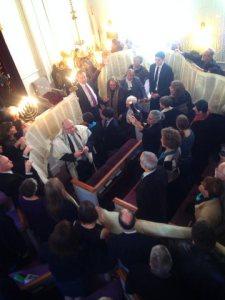
Photo credit Elizabeth Lucy
On Saturday, I attended Shabbat services in Honesdale PA, in the foothills of the Pocono mountains, in the same temple where my father became a Bar Mitzvah in 1937. The Delaware and Hudson Canal Company built this white clapboard synagogue with a steeple on the banks of the Lackawaxen River in 1856, in order to serve local Jewish merchants. Each year, more than 50 family members and friends return from across the country for a massive Thanksgiving meal, and to celebrate important rites of passage together at Congregation Beth Israel.
And so this year, as the convergence of Hanukkah and Thankgiving approached, we traveled from at least six different states, through snowy mountain passes, to witness my cousin Nora become a Bat Mitzvah. Nora lives outside Boston, but she is part of the sixth generation of our family to worship in what was once the tiniest temple in America. Throughout Shabbat, throughout a long weekend together that included celebrations of Hanukkah, Thanksgiving, the Bat Mitzvah, and my sister’s wedding, two themes recurred: Jewish continuity, and the inclusion in our family and our Jewish practice of people from across the world, and from across the spectrum of religions.
As always, as we entered the sanctuary, I searched the memorial yahrzeit plaques on the back wall, to find the names of my grandparents. In earlier generations, my family tree included cousins who married each other for lack of Jewish partners, as well as great-aunts and great-uncles who never married, never had children, for the same reason. Going through a box of photos from the last century in my grandmother’s house this week, I came across a photo with this scrawled on the back: “Leon’s Catholic girlfriend”. I adored my great-uncle Leon. He played fiddle, and worked in the family department store in Honesdale, and drew pictures of cats for us when we visited him at Katz Bros. The fact that he remained a bachelor uncle because he could not marry his Catholic sweetheart is poignant.
In the next two generations of my family, there have been a dozen happy interfaith marriages, starting with the wedding of my parents in 1960. Nora’s parents, my cousins Sig and Ruthie, are, like my own parents, Jewish and Episcopalian. I sat with my father and mother, now 89 and 82 and well past their 50th year of marriage, in the temple on Saturday morning. My teenage children sat up in the choir loft, singing with their first and second and third cousins.
Before Nora read from the Torah, we unrolled the scroll and wrapped it around the tiny sanctuary, circumscribing our radically inclusive community. My mother, who shepherded four Jewish children through the Bar and Bat Mitzvah process in the 1970s and 80s, was thrilled to be allowed to touch the parchment for the first time. Then Nora’s 91-year-old grandfather, my very erudite cousin Bill, who has spent most of his lifetime in this little town, devoting himself to Beth Israel, said the priestly blessing over the Bat Mitzvah girl from his wheelchair. There may have been one or two dry eyes in the house, but I couldn’t see them through the mist of my own tears.
In his words to Nora after her Torah reading, my cousin Sig referred to our synagogue as tiny but “huge if judged by the size of its metaphorical tent.” As a family now encompassing Jews and Catholics and Quakers and Episcopalians and Buddhists and humanists, those related by blood and those related by choice, we crammed into the familiar pews. We represent roots reaching from China to Italy, from Japan to Ireland, from Armenia to Colombia. And on Saturday, people with African, Russian, Danish, Polish and Dutch ancestors recited blessings over the Torah.
As a family, we cling to our quirky Classical Reform ways, eschewing yarmulkes and persisting in our love for familiar German tunes played on the organ, as well as incorporating Bach and Paul Simon and anyone else we please into our services. And yet somehow, we have not assimilated out of Jewish existence, through six generations at Beth Israel, and through three generations of being an interfaith family. My siblings and I have each made different decisions about the religious labels of our children, but all of us return to Honesdale, all of us return to Beth Israel, all of us are passing on love for Judaism.
On the night before Nora’s Bat Mitzvah, on the only night of the year that is Hanukkah Shabbat, my parents watched their seven grandchildren (some Jewish, some Catholic, some interfaith) light candles, say blessings, and sing Rock of Ages together. Recently, my Catholic nephew has been asking to learn Hebrew. So my daughter Aimee, who was raised in an interfaith community, with education in both Judaism and Christianity, taught her youngest Jewish and Catholic cousins to play dreidel. And thus she taught my nephew his first four Hebrew letters: nun, gimmel, hay, shin.
My father left Honesdale PA at age 17, but more than 70 years later, he still pays membership dues to Beth Israel. By the end of last week, my brother, the one raising three Catholic kids on the West Coast, had agreed to join the congregation as well. This is kind of crazy given the reality of geography, but also kind of gorgeous, and it makes sense within the context of our family. Our cousin Liza has agreed to be the next president of Beth Israel, and I trust that her creativity and open heart, her love of history and her embrace of all, will keep the congregation vibrant. Even if the Jewish ancestry in our family is but a single drop of holy oil, that drop will burn brightly for all to see, miraculous.

